Jean Reinhardt's Blog, page 24
July 6, 2017
Thursday Doors
I recently went for a drive up the Knockmealdown Mountains with an old friend of mine and we called on a lady she knew who rescues animals. Along with the dozen or more very friendly dogs that came to greet us there were some sheep and an imperious cockerel, strutting his stuff to his female companions.
[image error]
The results of all that strutting is plain to see in this next image.
[image error]
Adorable little black and white chicks. A couple of them had funny little ‘quiffs’ on their heads, which made them even cuter, and they live in a lovely little pink house.
[image error]
Sitting in the sunshine watching the antics of those chicks was so relaxing. We were very high up in the mountains, although you can’t really see this from the photos.
[image error] [image error]
When we lived in the area we had a view of the Knockmealdown Mountains and the Vee Pass from our house and often brought the kids up there on a picnic and to pick blackberries and bilberries. In some parts of Ireland the last Sunday in July was traditionally known as ‘Fraughan Sunday’ from the Irish name ‘fraochán’ meaning bilberry (much like a blueberry) and this was always a celebration as they are the first wild berries to ripen. In winter the mountains are always covered with snow, even when there isn’t so much as a flake on lower ground. I’m really going to miss them when we move.
Speaking of moving, my friend’s house is up for sale and I asked her if it was okay to feature it on Thursday Doors, so if anyone is interested, it’s in a beautiful setting. That drive to the mountains is on her doorstep and the sea is only fifteen minutes away.
[image error]
I love the stonework (I think part of it was once an old barn) and it has a half-door, which is always a winner with me. Not to mention that fabulous garden, some of which I’ll be taking with me as my friend has been rooting cuttings from her plants for me – honeysuckle, jasmine and some beautiful roses.
[image error]
I even managed to get myself into what Norm would call a ‘door-selfie’ 
June 29, 2017
Thursday Doors – Cork City
I’ve been searching through some photographs I took in Cork City earlier in the year and managed to find some I hadn’t already included in a Thursday Doors post. As we’ll be moving house soon, I’m confined to quarters sorting and packing so I haven’t been able to get out on any ‘doorscursions’ this week – we emptied the attic yesterday. I heard that groan of sympathy you let out. You’ve obviously been there and done that, so you know what a pain it is finding items you were sure had been donated to the charity shops years ago. Worse still, you end up putting them in the ‘might-be-worth-holding-onto’ pile, which always seems to be three times the size of the ‘definitely-must-go’ one. I thought this photo was very apt, seeing as I’m in the process of a house move.
[image error]
I like the Art Deco design on the pillars. The next image has pillars, too, which made it a bit of a challenge to get a clear view of a door – especially as this was a ‘drive-by’ shot from the car. It’s the entrance to St. Mary’s Church on Pope’s Quay (very appropriate address for a Roman Catholic church). The building dates back to 1832. If you look closely, you’ll see a man’s face on one of those doors. I have no idea who he is or why he’s been put there.
[image error]
There are lots of old buildings with pillars and arched windows to be found in Cork City.
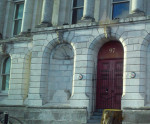



In contrast to the grandness of pillars and arched windows, many of the entrances to the older retail premises are plain painted wood. I like the look of the clothes shop below as it still retains that image of the drapery shops of my childhood. The kind that sold everything from a tablecloth to a Sunday suit for the man of the house. The Irish phrase over the door to this clothes shop translates as ‘Welcome in. The Best Men’s Clothes in Cork’ (they sell women’s clothes too) and it’s a long established family business. John Mannix, the owner, is an expert fitter. His father opened the store in 1928 and Mr. Mannix has been running it since the 1950’s when he was 19 years old. It’s great to see it still going today and still in the same family.
[image error]
When you look through the railings to the other side of the river, you can just about make out the large doors of converted warehouses and above them some lovely arched windows. That spire you see to the right belongs to the Trinity Presbyterian Church, which has been used for worship since its completion in 1861.
[image error]
If you think it is leaning to one side, you’d be correct. From the angle of this shot you can’t see it very well but there’s a distinctive kink in the spire. Now, there are two versions of the story as to how it got there; either the workmen did this deliberately to spite the architect or it was an accident through drunkenness! I quite like the idea of a bunch of well-oiled stonemasons looking up at their handiwork at the of the day and arguing over which of them put that block in the wrong place. You might see the kink better in this image from the Cork Heritage Open Day website. The longer I look at it, the more it seems to lean.
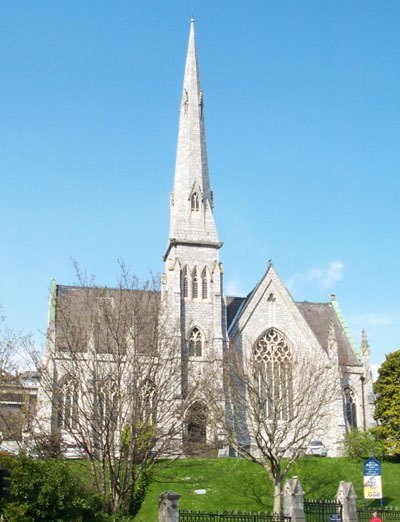
Source; Cork Heritage Open Day
Thanks for stopping by this week and if you fancy checking out more Thursday Doors, have a look at Norm’s blog (he’s the originator of Thursday Doors) and click the blue link at the end of his post.


June 22, 2017
Thursday Doors – Bristol
[image error]
This week’s Thursday Doors photos were taken by one of our daughters while on a recent visit to her brother in Bristol in the UK. I asked her to look out for some interesting doors that I could feature on my blog, and seeing as she’s an art student, it was the street art that caught her eye. Thank you for your contribution this week, Megan.
Click to view slideshow.
[image error]
This one’s a Banksy
Of course, you can’t photograph street art in Bristol and leave him out. Born there in 1974, Banksy was involved in the wave of street art that took the city by storm in the ’80s. Over the years, his work has appeared in London, Los Angeles and New York, as well as in his home town of Bristol. More recently, he’s been busy in France. Whatever your views are on street art, Banksy’s pieces make a statement and get a reaction. Have you seen this one?

It depicts Steve Jobs, the late co-founder of Apple, as a traveling migrant. (Jobs was the biological son of a Syrian migrant to the US). Banksy painted this one in the ‘Calais Jungle’, a nickname for the encampment in the French port were migrants lived while attempting to enter the UK. Talk about a picture painting a thousand words!
If you would like to know more about Banksy and Bristol, take a look at Visit Bristol. That’s where I came across the video tour and where you’ll find lots of links to all sorts of interesting places and things to do there, if you’re planning a visit.
There are lots more Thursday Doors to see over on Norm’s blog. Click the blue link at the bottom of his post to view them and you can even add your own.


June 15, 2017
Thursday Doors
[image error]
Does this look familiar? The front door hasn’t changed at all since I last posted it on Thursday Doors. That’s because we’ve been concentrating on the attic rooms, which are coming along nicely – considering we’re not exactly spring chickens. Downstairs makes a nice dry workshop, for now. Upstairs is beginning to look like a home.


We even have a couple of pieces of furniture in one of the bedrooms. That’s Tino, the gaffer, sitting on the best chair, keeping a shrewd eye on us. He looks exhausted because it’s very tiring watching people work all day. Of course, he does allow us to stop for a coffee break.
[image error]
When he sees us sprawled out on the floor, unable to lift a nail (the metal kind) he gets the hint and calls ‘elevenses’. Being the slave-driver he is, that’s not usually until twelve o’clock!
[image error]
But the gaffer’s efforts are paying off as we managed to finally get the plasterboard or drywall up and the first part of the partition walls done. We even have flowers, of a sort, in the garden.
[image error]
I’m hoping this is what we call Rocket. If it is, I’d like to save it when we tackle the garden – we may have no money left by then and it’s an edible plant.
‘Dame’s rocket has an interesting history in terms of its names. It was called the Vesper-flower, because it emits its perfume in the evening, and this is how the genus got its name “Hesperis” means evening. Dame’s rocket can grow to heights of more than 3 feet and is a native of Europe and Asia. It has naturalized in North America and is invasive in several states. In Britain it has been cultivated for centuries, and so has become naturalized in some places being a garden escapee.’ *
[image error]
The best part about working on the house is definitely staying on the boat. The sky always seems to be different each time we visit and the water reflects it so beautifully. This is what squally weather approaching looks like. My camera didn’t do nature’s colours justice.
[image error]
Hope I haven’t tired you out with this Thursday Doors renovating post. I’m sure there are a lot more serene doors to be seen over on Norm’s blog. Have a great weekend and thanks for stopping by.


June 8, 2017
Thursday Doors
[image error]
We drive past this door almost every time we are in Cork City and it always catches my eye and cries out to be a Thursday Door. It’s set in a very long stone wall.
[image error]
The wall eventually leads to a couple of windows but I’m not sure if the door and windows are part of the same property. There are lots of similar stone buildings dotted around the city and many of them are still in use, like Coláiste Daibhéid (David’s College) a post primary school that teaches through the Irish language. It’s in Sawmill Street and adjacent to St. John’s Central College that I featured in last week’s Thursday Doors.
[image error] [image error]
At the top of the Sawmill Street there is a row of lovely old Victorian houses in Newenham Terrace. The gates were closed so I couldn’t get any closer but you can see from the photo they are well preserved in their original state, even retaining their old sash windows. Nice to see a red door in there, too.
[image error]
Sawmill Street leads onto Infirmary Road, a busy place to try and take photographs but I managed to get a shot of another old building – City General Hospital.
[image error]
Next to this is the Victoria Hospital, which has a lovely arched entrance and an equally lovely red door.
[image error]
The Victoria Hospital first opened its doors in a different location in 1874 and was known at the time as The County and City of Cork Hospital for Women and Children. It was moved to its present site in 1885. The name was changed to The Victoria Hospital for Women and Children in 1901 and male patients were first admitted in 1914.
The fact that I featured two hospital buildings in this week’s post might have something to do with my aching joints, having spent a week working on our old house. But it’s beginning to look and feel a bit more habitable now (on the inside, at least), so it’s well worth the effort.
Thank you for joining me on this tour of Sawmill Street/Infirmary Road on this week’s Thursday Doors. There are lots more doors to see over on Norm’s blog, from many different parts of the globe.


June 1, 2017
Thursday Doors – College
[image error]
For me, this is a very special Thursday Doors post. This month, our youngest has just completed a Fetac Level 5 course in Art, Craft and Design at St. John’s college, Cork. This is a long established portfolio course and many of its graduates go on to study in various art and design colleges throughout Ireland and the UK. By sampling a wide choice of components, students are given the opportunity to try out different branches of the arts before committing to a higher education course. The work done throughout the year was on exhibition at the college. I hope you can see from the photographs how much effort and creativity went into these projects.
This colourful door led us to Graphic Design.
[image error]
Another door led to Jewelry & Art Metal Craft
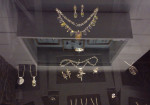





Then we made our way to Fashion Design






There was even a course in Musical Instrument Making & Repair


Below are some examples of the Art, Craft & Design course that my daughter attended. I was amazed by the wide variety of creative ideas and how each student has developed their own unique style.









I was also very impressed by this student’s work.



But I’m biased – I’m her mother!
Thanks so much for stopping by. If you would like to view more Thursday Doors, have a look at Norm’s blog and follow the blue ‘frog’ link at the bottom of his post – and if you have a door or two of your own to share, why not join in the fun.


May 25, 2017
Thursday Doors – Derry Again
[image error]
I’m still in Derry for this week’s Thursday Doors and this was as high as I could go in the Tower Museum. The view from the rooftop is wonderful, with the River Foyle cutting through the city in the background.
[image error]
The exhibits inside are pretty good to look at, too. One of them was of a WW2 American fighter pilot’s flying helmet and medical kit bag.
[image error]
In 1941, twenty-three year old Roland ‘Bud’ Wolfe, from Nebraska, bailed out of his Spitfire when its Rolls Royce Merlin engine overheated. He survived both the crash and the second World War to fly in Korea and Vietnam. Wolfe died in Florida in 1994 at the age of 76. The plane, however, plunged into a peat bog in Derry’s neighbouring county, Donegal, where it lay twenty feet underground for seventy years. Following a number of failed attempts by others, the wreckage was discovered in 2011 by aviation historian, Jonny McNee, and his daughter, Grace.
[image error]
The Spitfire’s Engine.
This particular Spitfire was the first of 20 aircraft commissioned with a £100,000 donation from Canadian millionaire Willard Garfield Weston, during the Battle of Britain. Here’s what Mr. McNee had to say about his find; “This is the Holy Grail of Spitfires because of the tremendous history involved in it and the fact that it was the first Garfield Weston presentation plane. It has ‘Garfield Weston No 1’ written in 4-inch yellow letters down the side of the cockpit.” (All you aviation enthusiasts will understand the significance of this).
Another interesting exhibit at the museum is this cannon, from one of the ships of the Spanish Armada.
[image error]


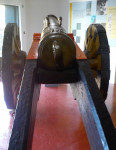
[image error]
This large bronze cannon from the ship, La Trinidad Valencera, is dated 1556 and bears King Philip of Spain’s coat of arms. It sits on a beautifully crafted replica gun carriage. An original wheel in the images below was found covered in solidified sand and silt. These siege cannons, with such enormous carriages and wheels, give evidence that the main intent of the Spanish Armada was for a land invasion rather than a naval conflict.


King Philip gave the restoration of England to Catholicism as his reason for the invasion in 1588, but commercial and political objectives played a large part in it. Spain’s interests in the New World were increasingly under attack by the English and needed protection.
Although it was one of the most ambitious military undertakings in history, the Spanish Armada was also one of the greatest failures. The ships were not only driven away by the English navy but were blown off course and scattered by strong gales. Many were wrecked off the coasts of Ireland and Scotland with a loss of one third of the vessels and two thirds of the men. With 42 guns, La Trinidad Valencera was the fourth largest ship in the Armada. She eventually reached Kinnegoe Bay, County Donegal, where she remained afloat for two days before breaking up and sinking, in September 1588. On 20th February 1971, she was discovered 150 metres offshore and 10 metres underwater by divers Archie Jack and Paddy Stewart, members of the City of Derry Sub-Aqua Club.
Most of La Trinidad Valenceria’s crew and soldiers got safely to shore. When they tried to negotiate an honourable surrender to the local militia, which was under English command, 300 of the 450 shipwrecked men were massacred. Sadly, only half of the 150 who escaped finally reached Spain.
[image error]
Thought I should end a Thursday Doors post with an image of a door – a red one, of course. 
Thursday Door – Derry Again
[image error]
I’m still in Derry for this week’s Thursday Doors and this was as high as I could go in the Tower Museum. The view from the rooftop is wonderful, with the River Foyle cutting through the city in the background.
[image error]
The exhibits inside are pretty good to look at, too. One of them was of a WW2 American fighter pilot’s flying helmet and medical kit bag.
[image error]
In 1941, twenty-three year old Roland ‘Bud’ Wolfe, from Nebraska, bailed out of his Spitfire when its Rolls Royce Merlin engine overheated. He survived both the crash and the second World War to fly in Korea and Vietnam. Wolfe died in Florida in 1994 at the age of 76. The plane, however, plunged into a peat bog in Derry’s neighbouring county, Donegal, where it lay twenty feet underground for seventy years. Following a number of failed attempts by others, the wreckage was discovered in 2011 by aviation historian, Jonny McNee, and his daughter, Grace.
[image error]
The Spitfire’s Engine.
This particular Spitfire was the first of 20 aircraft commissioned with a £100,000 donation from Canadian millionaire Willard Garfield Weston, during the Battle of Britain. Here’s what Mr. McNee had to say about his find; “This is the Holy Grail of Spitfires because of the tremendous history involved in it and the fact that it was the first Garfield Weston presentation plane. It has ‘Garfield Weston No 1’ written in 4-inch yellow letters down the side of the cockpit.” (All you aviation enthusiasts will understand the significance of this).
Another interesting exhibit at the museum is this cannon, from one of the ships of the Spanish Armada.
[image error]



[image error]
This large bronze cannon from the ship, La Trinidad Valencera, is dated 1556 and bears King Philip of Spain’s coat of arms. It sits on a beautifully crafted replica gun carriage. An original wheel in the images below was found covered in solidified sand and silt. These siege cannons, with such enormous carriages and wheels, give evidence that the main intent of the Spanish Armada was for a land invasion rather than a naval conflict.


King Philip gave the restoration of England to Catholicism as his reason for the invasion in 1588, but commercial and political objectives played a large part in it. Spain’s interests in the New World were increasingly under attack by the English and needed protection.
Although it was one of the most ambitious military undertakings in history, the Spanish Armada was also one of the greatest failures. The ships were not only driven away by the English navy but were blown off course and scattered by strong gales. Many were wrecked off the coasts of Ireland and Scotland with a loss of one third of the vessels and two thirds of the men. With 42 guns, La Trinidad Valencera was the fourth largest ship in the Armada. She eventually reached Kinnegoe Bay, County Donegal, where she remained afloat for two days before breaking up and sinking, in September 1588. On 20th February 1971, she was discovered 150 metres offshore and 10 metres underwater by divers Archie Jack and Paddy Stewart, members of the City of Derry Sub-Aqua Club.
Most of La Trinidad Valenceria’s crew and soldiers got safely to shore. When they tried to negotiate an honourable surrender to the local militia, which was under English command, 300 of the 450 shipwrecked men were massacred. Sadly, only half of the 150 who escaped finally reached Spain.
[image error]
Thought I should end a Thursday Doors post with an image of a door – a red one, of course. 
May 18, 2017
Thursday Doors – Secret Cargo
[image error]
These Thursday Doors lead into the Tower museum in Derry, Northern Ireland. The Laurentic exhibition is on there at the moment and my granddaughter had just been on a school trip to see it. It must have been interesting if she came along for a second viewing.
[image error]
25th January 2017 was the 100th anniversary of the sinking of the HMS Laurentic by a German mine in Lough Swilly, county Donegal. The luxury liner was carrying, what was valued at the time as, £5 million worth of gold. Sadly, 350 of the 500 crew drowned and they are commemorated in a memorial in a churchyard on the banks of Lough Swilly.
[image error]
Image source; John Oxley Library, State Library of Queensland. Public Domain.
99% of the gold was recovered by a British naval salvage team. But what happened to the remainder of the gold? The 1% still missing today is valued at approximately £2 million.
The HMS Laurentic was owned by the White Star Line, which was among the first of the shipping lines to fit out passenger ships with inexpensive accommodation for third-class passengers, along with berths for higher paying first and second class. On its last voyage the Laurentic was scheduled to deliver a very important cargo to Halifax, Nova Scotia, but at the time, the captain was unaware of what he was carrying. The secret cargo was a payment to America and Canada for supplying Britain with munitions and other machinery for the war effort. This was in the form of 43 tons of gold bullion, consisting of 3,211 bars. Today’s value would be in the region of £300 million. This last fatal voyage made the Laurentic famous, but not quiet as famous as other liners, such as the Lusitania and the Titanic.
Some of the items on display at the exhibition

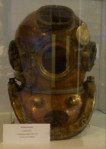

Another interesting story associated with the Laurentic was its involvement in the capture of the murderer, Dr. Hawley Crippen, in July 1910. Having killed his wife, Dr Crippen fled with his mistress, Ethel Le Neve, to the port of Antwerp in Belgium, where they boarded the SS Montrose for Canada. They planned on crossing the border into the USA to begin a new life together. He traveled under the name of Robinson and Ethel posed as his teenage son. But they they were a bit too ‘friendly’ and their suspicious behaviour came to the attention of the captain. He sent a report off to Scotland Yard, making this the first time the new Marconi signalling device was used in a murder case. Chief Inspector Walter Dew, leading the investigation, gave chase by booking a passage on the fastest ship available, which happened to be – the Laurentic. Because of its speed compared to that of the older ship, he arrived three days ahead of them. He disguised himself as a river pilot, and boarded the Montrose, arresting Crippen and his mistress. Guess what ship he brought his prisoners back to England on. None other than the Laurentic.
I’ll spare you the gory details of Mrs. Crippen’s untimely demise but if you’d like to read more, here’s the link on History Today.
It was lovely having you on board the blog today, why not sail on over to Norm’s for an interesting collection of Thursday Doors?


May 17, 2017
Photo Challenge – Reflecting
[image error]
The Erne River in County Cavan, Ireland.
In response to WordPress Daily Post photo challenge: Reflecting.





